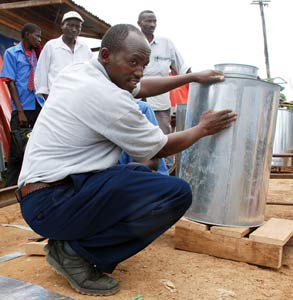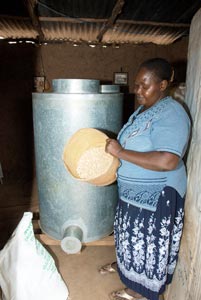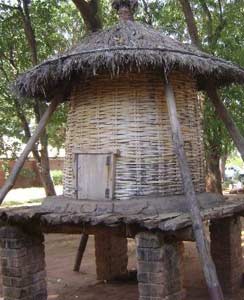Farmers in developing countries typically lose 20-30% of their crop due to poor grain storage facilities. Through a project with roots in Central America, African maize farmers are adopting metal silos to protect their families’ food supply and source of income.
 Six mouths are a lot to feed so Pamela Akoth, a 39-year-old Kenyan farmer and mother to half a dozen children, doesn’t want any weevils or borers—two of the most common post-harvest pests—nibbling at her grain supply. Akoth grows maize on 0.7 hectares in Homa Bay, western Kenya. In the past, she stored her grain in a traditional granary: a structure built with mud, branches, and cow dung that allows free entry to the maize weevil and the larger grain borer, the two most damaging pests of stored maize in Africa. Infestation starts in the field and continues after harvest when grain is stored. Losses of 10-20% are reported three months after storage, and this goes up to more than 50% after six months.
Six mouths are a lot to feed so Pamela Akoth, a 39-year-old Kenyan farmer and mother to half a dozen children, doesn’t want any weevils or borers—two of the most common post-harvest pests—nibbling at her grain supply. Akoth grows maize on 0.7 hectares in Homa Bay, western Kenya. In the past, she stored her grain in a traditional granary: a structure built with mud, branches, and cow dung that allows free entry to the maize weevil and the larger grain borer, the two most damaging pests of stored maize in Africa. Infestation starts in the field and continues after harvest when grain is stored. Losses of 10-20% are reported three months after storage, and this goes up to more than 50% after six months.
On the advice of the Catholic Diocese of Homa Bay and with help from a subsidy program—the Agriculture and Environment Program (AEP) of the Diocese of Homa Bay helps needy farmers to acquire metal silos by providing interest-free loans—Akoth purchased a metal silo able to store 20 bags (1,800 kilograms) of maize; roughly what her land yields. Made of galvanized metal, the silo is airtight, so it keeps out insects and suffocates any that might have snuck in with the stored grain. “I am happy that since I started using the silo I don’t experience any loss of grain,” Akoth says. “I have enough to feed my family and even some left over that I can save and later sell, when there is a shortage in the market.”
Akoth is one of many farmers who has benefited from the Effective Grain Storage Project. Supported by the Swiss Agency for Development and Cooperation (SDC) and the generous unrestricted contributions CIMMYT receives, this effort aims to improve food security in sub-Saharan Africa through effective on-farm storage technologies, like metal silos. Participants are promoting the silos and training artisans who build and sell them. “The focus of the project is to ensure that farmers use only well-fabricated, high-quality metal silos,” says Fred Kanampiu, CIMMYT agronomist and former project head. “We are training artisans who will make and sell these silos.”
 Local manufactureres cash in on silo demand
Local manufactureres cash in on silo demand
The Effective Grain Storage Project has supported two artisan workshops in Homa Bay and Embu, with a total of 37 artisans trained. One of these is Eric Omulo Omondi, a 23-year-old metal worker based in Homa Bay. Along with 29 other artisans, he attended a free training workshop on metal silo construction in 2009. Since then, Omondi has made 15 metal silos and his average monthly income has tripled.
“I was lucky enough to have been selected by the diocese as one of the artisans to be professionally trained,” Omondi says. The training exercise was facilitated by CIMMYT, who contracted a skilled artisan from Central America. There and in South America and the Caribbean, the POSTCOSECHA program (also funded by SDC) had launched the use of metal silos for storing maize grain, significantly reducing post-harvest losses among more than 300,000 families.
To date, the current project is responsible for the construction of 146 silos across Kenya and Malawi. Two strong local partners, World Vision International in Malawi, and the Catholic Dioceses of Embu and Homa Bay in Kenya, host training sessions and promote metal silo use. In Malawi, metal silos have been used since 2007, initially supplied by a private company contracted by the government to distribute silos throughout the country. “Over the past few years, farmers have recorded high maize harvests, and now even request silos of a 7.5 ton capacity,” says Essau Phiri of World Vision-Malawi.
In Mchinji District, Central Malawi, artisan Douglas Kathakamba has benefited from the CIMMYT-World Vision collaboration. He launched his metal works business making ox-carts, door and window frames, and bicycle ambulances, but has found even greater profit since 2007 by building metal silos. As a result of silo income, he has set up a new workshop, sent his five children to school, and even covers the costs of university studies for two adopted children.
From sacks to sheet metal
Douglas is now an ardent supporter of the metal silo and receives many customers through referrals. He also educates rural farmers. In Kachilika Village of northern Malawi, he has recently worked with a farmers’ club that had never heard of metal silos. The 25 members store their grain communally and, after Douglas constructed and donated a silo to them, commissioned him to build four more. With the proceeds from increased grain sales, the members now pay for children’s schooling and purchase items such as clothing, domestic products, and farm inputs for the next season.
“Before the introduction of silos, we were using sacks and nkhokwe (the traditional granary), but we were not able to save much,” says Andrew Kasalika, the club chairman. “Now, we can say that our lives have changed.”
A particularly dedicated safe storage advocate in Kenya is Sister Barbara Okomo, a former Homa Bay teacher and current principal of St. Theresa’s Girls’ Secondary School in Kisumu, roughly a two hour drive from Homa Bay. Since she started working with the Diocese’s Agriculture and Environment Program (AEP), Okomo has had artisans fabricate 40 metal silos at her schools, which include 10 at her current school. The silos are made on-site to cut costs and make it easier for potential adopters.
 “I have used the silos for several years now, and I am convinced that this is the best method to store grain,” Sister Barbara says. “With other storage methods, we would lose up to 90% of our stored grain—now we lose nothing.” Schools have been early adopters of metal silos because many grow and store grain year-long to feed their students.
“I have used the silos for several years now, and I am convinced that this is the best method to store grain,” Sister Barbara says. “With other storage methods, we would lose up to 90% of our stored grain—now we lose nothing.” Schools have been early adopters of metal silos because many grow and store grain year-long to feed their students.
To save you need to spend
A challenge for African farm households is the initial costs of a silo. They are relatively cheap—in Homa Bay, a three-bag silo costs about USD 74 and a 20-bag silo USD 350—and with an effective lifetime of more than a decade, the silos more than pay for themselves, in terms of food security and surplus grain savings. But the average monthly cash income of a Homa Bay farmer ranges from USD 40 to 130. This means that family heads often have to choose between providing basic needs and investing in the silo. “Without support from the Diocese, I wouldn’t have been able to buy a silo,” says Akoth. Representatives of Equity Bank have met with stakeholders in Homa Bay to discuss micro-finance opportunities that would allow many more farmers to purchase metal silos. Micro-financing would also help more artisans enter the emerging silo industry, as current investment capital costs are high.
“Metal silos bring food security to the poor,” says Tadele Tefera, the current EGS project coordinator. “Not only what farmers harvest, but more importantly, what they store over seasons, could make a difference in their livelihoods.”
A recent (June 2010) news feature on metal silos, aired in Kenya, gives testimonials on the success of the silos from local users.
Further information: Tadele Tefera, Project Coordinator, Effective Grain Storage (t.tefera@cgiar.org)

